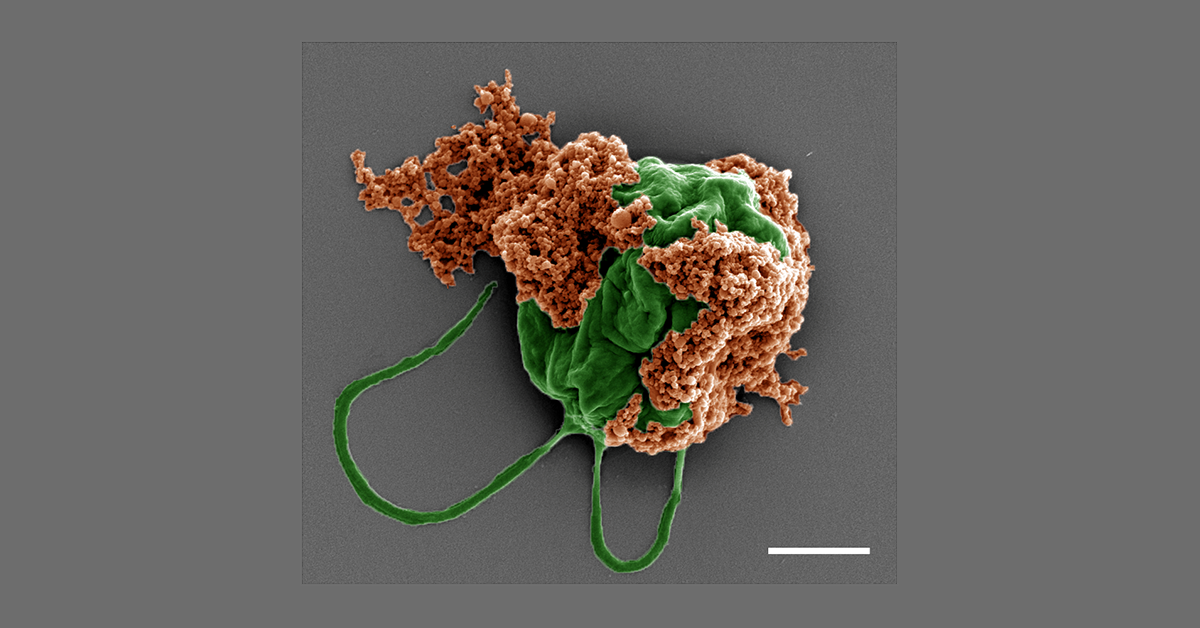Researchers from the University of California San Diego have created microscopic robots, or microrobots, that can travel through the lungs and deliver cancer-fighting drugs straight to metastatic tumors. This strategy has demonstrated its effectiveness in mice by slowing the growth and spread of lung-metastasizing tumors, increasing survival rates compared to control therapies. The results were published in the journal Science Advances.
 Colored SEM image of a microrobot made of an algae cell (green) covered with drug-filled nanoparticles (orange) coated with red blood cell membranes. Scale bar: 2 µm. Image Credit: Zhengxing Li
Colored SEM image of a microrobot made of an algae cell (green) covered with drug-filled nanoparticles (orange) coated with red blood cell membranes. Scale bar: 2 µm. Image Credit: Zhengxing Li
The microrobots are a clever fusion of nanotechnology and biology. These are a collaborative effort between the labs of Joseph Wang and Liangfang Zhang, Professors at the UC San Diego Jacobs School of Engineering's Aiiso Yufeng Li Family Department of Chemical and Nano Engineering.
Researchers chemically bonded drug-filled nanoparticles to the surface of green algae cells to construct the microrobots. The algae, which also provides the microrobots with movement, makes it possible for the nanoparticles to effectively swim around in the lungs and deliver their therapeutic payload to tumors.
The chemotherapy medication doxorubicin is placed into tiny, biodegradable polymer spheres coated in red blood cell membranes to form the nanoparticles. This coating is important for shielding the nanoparticles from the immune system so they can remain in the lungs long enough to start working against the tumor.
It acts as a camouflage, this coating makes the nanoparticle look like a red blood cell from the body, so it will not trigger an immune response.
Zhengxing Li, Study Co-First Author, University of California San Diego
Li is a nanoengineering Ph.D. student in both Wang and Zhang’s research groups.
The researchers concluded that this formulation of algae that carries nanoparticles is harmless. The U.S. Food and Drug Administration has certified Chlamydomonas reinhardtii, a type of green algae, as safe for use with the materials used to create the nanoparticles.
This study expands on earlier research by Wang and Zhang's groups, which used comparable microrobots to treat mice's fatal pneumonia.
Wang said, “Those were the first microrobots to be safely tested in the lungs of live animals.”
In earlier research, the microrobots used a different medication and combination of cell membranes for the nanoparticles to combat spreading bacteria that cause pneumonia. The team has now modified these parts to better fit the microrobots in their mission to stop lung cancer cells from spreading.
We demonstrate that this is a platform technology that can actively and efficiently deliver therapeutics throughout the entire lung tissue to combat different types of deadly diseases in the lungs.
Liangfang Zhang, Professor, School of Engineering, University of California San Diego
Mice with melanoma that had metastasized to the lungs were treated with microrobots. These microrobots were administered to the lungs through a small tube inserted into the windpipe. Treated mice experienced a median survival time of 37 days, an improvement over the 27-day median survival time observed in untreated mice and in mice that received either the drug alone or drug-filled nanoparticles without algae.
The active swimming motion of the microrobots significantly improved distribution of the drug to the deep lung tissue, while prolonging retention time. This enhanced distribution and prolonged retention time allowed us to reduce the required drug dosage, potentially reducing side effects while maintaining high survival efficacy.
Zhengxing Li, Study Co-First Author, University of California San Diego
The team is seeking to advance this microrobot treatment to trials in larger animals with the goal of eventually conducting clinical studies on humans.
The study's co-authors are Fangyu Zhang, Zhongyuan Guo, Zhengxing Li, Hao Luan, Yiyan Yu, Audrey T. Zhu, Shichao Ding, Weiwei Gao, and Ronnie H. Fang.
The Defense Threat Reduction Agency Joint Science and Technology Office for Chemical and Biological Defense and the National Institutes of Health funded the study.